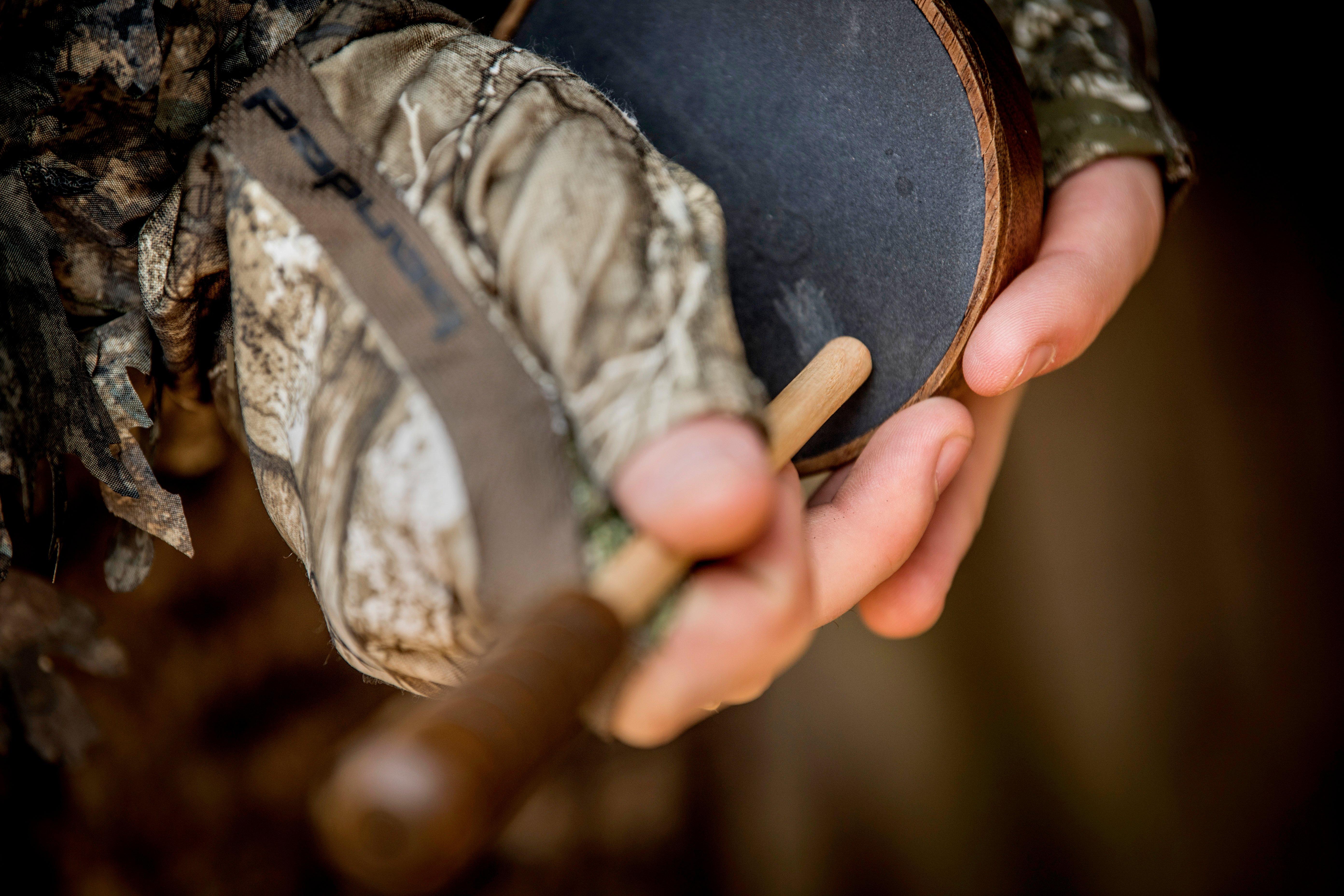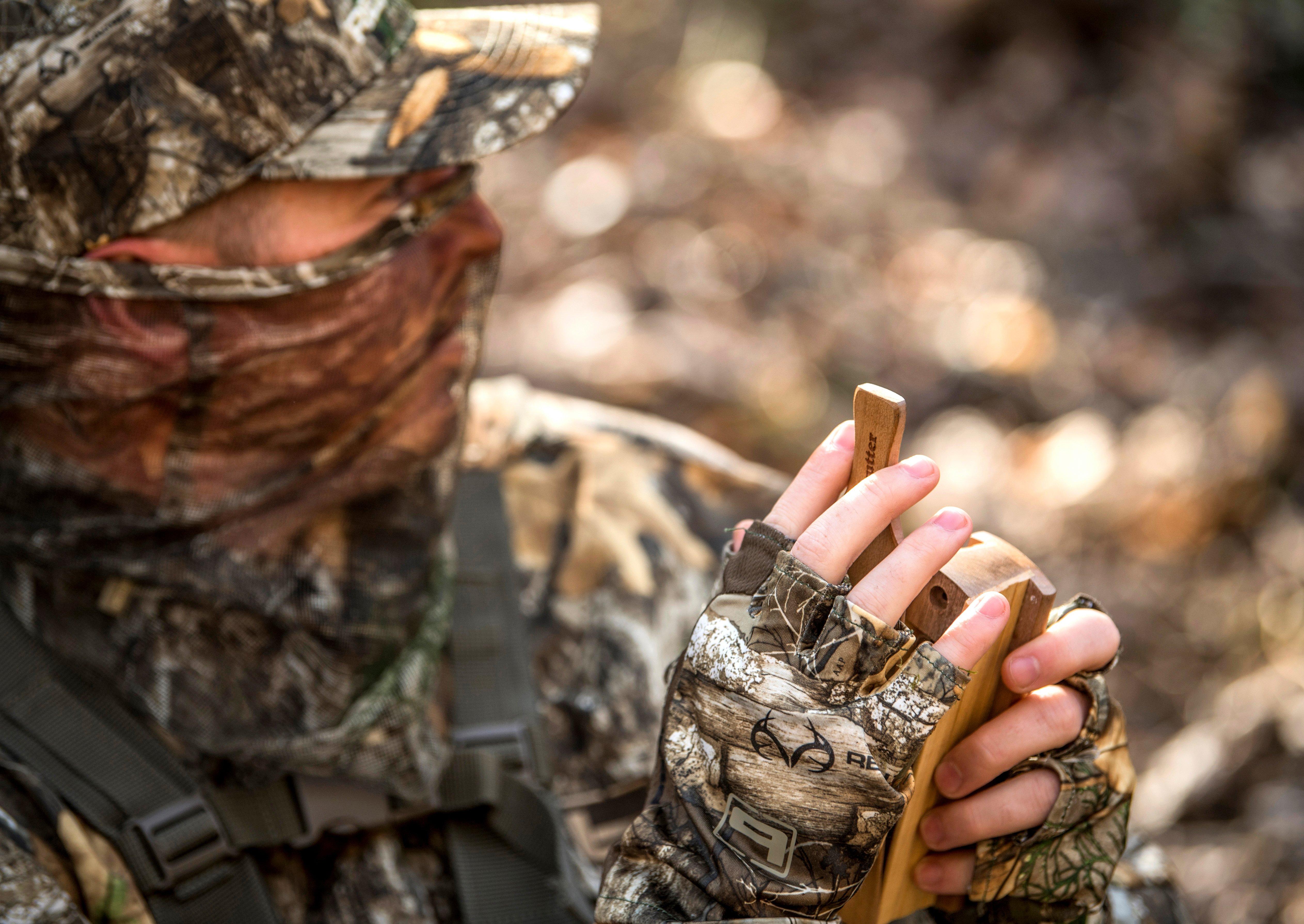Take your box, pot and push-peg calling game to another level this spring

The sweet-talking slate call is a tried-and-true friction calling device. Image by Bill Konway
To my ear, a slate or wooden box call sounds more like a real hen turkey than any other calling device. Here are three of my favorite friction tricks to bring a gobbler body-rocking into shotgun range.
TREE YELP ON A SLATE
When hens wake on the roost, they start the day with soft calls that say, “All’s well” to other turkeys in the area. Audio studies have shown that the typical tree yelp has four to six short, muted notes, and each note has the same low volume and pitch. Depending on the terrain and foliage, tree yelps can be heard up to 100 yards away.
A slate call with a hickory striker is my go-to for tree yelps. Pull it out of your vest as you sneak within 100 yards of a gobbling turkey in the pre-dawn. Listen closely. If you don’t hear live hens calling nearby, you’re in business.
Sit and scratch out a very soft four-note yelp. If the bird booms a gobble back, you might not have to call again. But if you receive no response, yelp again a bit louder, until the turkey gobbles and honors you as a hen. Set the call aside, and listen for him to fly down. When he’s on the ground, you can cluck and yelp with a little more vigor.
Slate tips: Hold the pot call and striker lightly. Place the striker at a 45-degree angle to the slate, and work lightly in tiny lines or ovals to tree yelp. Rub the slate and striker tip frequently with fine sandpaper for the best friction.

Box calls are excellent for cutting through the wind. Image by Bill Konway
CUTT AND RUN WITH A BOX
As a lonesome hen wanders around at midmorning, she’ll often cutt to locate and hook up with other hens or a gobbler. A typical cutting sequence consists of fast, aggressive clucks strung together for three to five seconds.
Covering ground and cutting on a wooden box is my favorite way to locate gobblers that strut silently in the woods at midday. It’s fun, lively calling, but don’t overdo it and string together too many long, loud clucks that can cover up a distant turkey’s gobble. I typically cutt in sharp three-second bursts. Then I stop abruptly and listen. One shock gobble is often all you’ll get, but that’s all you need. Sneak 50 to 100 yards in that direction, and cutt again. If he gobbles back, find a calling spot, and go to work.
Box call tips: For maximum volume, hold a box away from your body, and point it toward a ridge, hollow or bottom where a tom might be strutting. The vertical hold works best for me. Lay the call flat in your palm, and turn your hand and the box perpendicular to the ground. Bear down on the call’s handle or lid, and pop a series of short, fast, sharp clucks. Chalk the call as needed.
FIGHT-PURR WITH PUSH-PEGS
Some days, you’ll encounter a breeding flock consisting of several hens, a dominant strutter and a couple of subordinate toms hanging on the fringes. If the turkeys encroach on one another’s space, a stand-off ensues, and the birds often screech a rattle or fighting purr. It’s a sharp, machine-gun like series of aggravated purrs uttered before a fight breaks out.
It can be frustrating to sit and yelp to a breeding flock. A turkey or two booms back gobbles but never intends to come your way. As a last-ditch effort, try cutting loose some fighting purrs of your own. Whether people or turkeys, fight sounds can attract a crowd.
Although you can run two push-peg calls (one in each hand) to make the sparring ruckus, this technique works best when hunting with a buddy. Two guys set up 20 yards apart, and each works a push-peg feverishly to sound like two aggravated gobblers. For added realism, flap your cap in leaves to mimic wingbeats.
In my experience, fight purring works best to excite subdominant gobblers, break them from a flock and pull them into gun range. If a jake comes to my fight, I’ll pass. If it’s a 2-year-old with a 9-inch beard, I’ll happily take him.
Push-peg tips: Hold the call in one hand and tap the peg hard and rapidly against your opposite palm or against your leg. Pop out an eight- to 12-second series of loud, aggressive purrs, flap your cap in the leaves, and repeat that a couple of more times. I’ve had gobblers break and run to these chaotic calls, so be ready.
Don’t Miss: 10 OLD-SCHOOL TURKEY HUNTING TIPS










